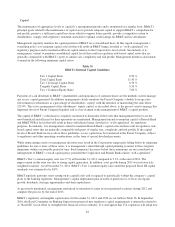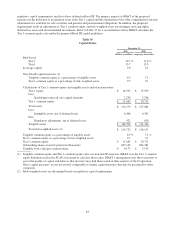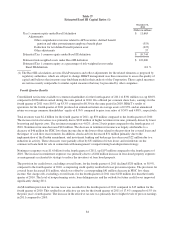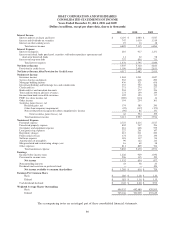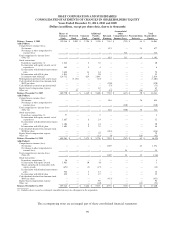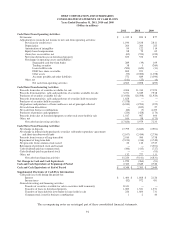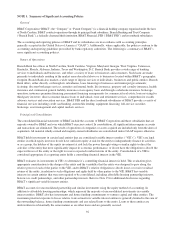BB&T 2011 Annual Report Download - page 82
Download and view the complete annual report
Please find page 82 of the 2011 BB&T annual report below. You can navigate through the pages in the report by either clicking on the pages listed below, or by using the keyword search tool below to find specific information within the annual report.Capital
The maintenance of appropriate levels of capital is a management priority and is monitored on a regular basis. BB&T’s
principal goals related to the maintenance of capital are to provide adequate capital to support BB&T’s comprehensive
risk profile, preserve a sufficient capital base from which to support future growth, provide a competitive return to
shareholders, comply with regulatory standards and achieve optimal credit ratings for BB&T and its subsidiaries.
Management regularly monitors the capital position of BB&T on a consolidated basis. In this regard, management’s
overriding policy is to maintain capital at levels that will result in BB&T being classified as “well-capitalized” for
regulatory purposes and to maintain sufficient capital relative to the Corporation’s level of risk. Secondarily, it is
management’s intent to maintain consolidated capital levels that result in regulatory risk-based capital ratios that are
generally comparable with BB&T’s peers of similar size, complexity and risk profile. Management monitors and intends
to maintain the following minimum capital ratios:
Table 35
BB&T’s Internal Capital Guidelines
Tier 1 Capital Ratio 8.50 %
Total Capital Ratio 11.50 %
Tier 1 Leverage Capital Ratio 6.50 %
Tangible Capital Ratio 5.50 %
Tier 1 Common Equity Ratio 7.00 %
Payments of cash dividends to BB&T’s shareholders and repurchases of common shares are the methods used to manage
any excess capital generated. In addition, management closely monitors the Parent Company’s double leverage ratio
(investments in subsidiaries as a percentage of shareholders’ equity) with the intention of maintaining the ratio below
125.0%. The active management of the subsidiaries’ equity capital, as described above, is the process used to manage this
important driver of Parent Company liquidity and is a key element in the management of BB&T’s capital position.
The capital of BB&T’s subsidiaries is regularly monitored to determine if the levels that management believes are the
most beneficial and efficient for their operations are maintained. Management intends to maintain capital at Branch Bank
and BB&T FSB at levels that will result in these subsidiaries being classified as “well-capitalized” for regulatory
purposes. Secondarily, it is management’s intent to maintain Branch Bank’s capital at levels that result in regulatory risk-
based capital ratios that are generally comparable with peers of similar size, complexity and risk profile. If the capital
levels of Branch Bank increase above these guidelines, excess capital may be transferred to the Parent Company, subject
to regulatory and other operating considerations, in the form of special dividend payments.
While nonrecurring events or management decisions may result in the Corporation temporarily falling below its minimum
guidelines for one or more of these ratios, it is management’s intent through capital planning to return to these targeted
minimums within a reasonable period of time. Such temporary decreases below these minimums are not considered an
infringement of BB&T’s overall capital policy provided the Corporation and Branch Bank remain “well-capitalized.”
BB&T’s Tier 1 common equity ratio was 9.7% at December 31, 2011 compared to 9.1% at the end of 2010. The
improvement in this ratio was due to strong capital generation. In addition, asset growth during 2011 was in lower risk-
weighted securities. As of December 31, 2011, BB&T’s Tier 1 common equity ratio under the proposed Basel III capital
standards was estimated to be 8.8%.
BB&T regularly performs stress testing on its capital levels and is required to periodically submit the company’s capital
plans to the banking regulators. Management’s capital deployment plan in order of preference is to focus on organic
growth, dividends, strategic opportunities and share repurchases.
As previously mentioned, management announced its intentions to retire its trust preferred securities during 2012 and
complete the process by the end of 2013.
BB&T’s regulatory and tangible capital ratios for December 31, 2011 and 2010 are set forth in Table 36. In September
2010, the Basel Committee on Banking Supervision proposed new regulatory capital requirements (commonly referred to
as “Basel III”) in an effort to strengthen the financial services industry. It is anticipated that U.S. regulators will adopt new
82












